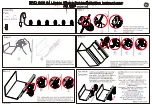
4. A
PPLICATION
D
ESIGN
C
ONSIDERATIONS
H
I
R
OLLER
- B
ELT
C
ONVEYORS
4.2. C
LEARANCES
H
I
R
OLLER
, M
INI
R
OLLER
, L
O
R
OLLER
& H
I
L
IFE
28
P115506 R3
H
OT
M
OIST
M
ATERIAL
• A 2356 cfm system based on two 6” lines at approximately 6000 fpm is
required to keep the lines clean. The aspiration lines will have to be insulated
to eliminate condensation on the inside of the lines. Pickup hoods will be
required on the top of the conveyor so product dust is not picked up by the air
(Figure 4.2).
• Tail section air intake: Approximately 10-20% of the total cfm. Fresh air will
remove any buildup of moisture in the tail area.
• Product flow into the conveyor inlet/loader: Air flow should be eliminated as
much as possible.
• Head section area air intakes: Balance of the total cfm - several intakes.
Note:
Many applications will also require that the conveyor be well insulated.
Figure 4.2
C
ONDENSATION
P
REVENTION
•
Warm/moist air
must not be allowed to vent through the conveyor because it
will cause condensation to form on the inside of the conveyor enclosure as
the dew point of the air is reached. Condensation or water can freeze inside
the conveyor and cause substantial problems.
•
Warm/hot moist materials
will create warm moist air inside the conveyor
enclosure and can cause extensive damage through condensation and freez-
ing.
•
Proper insulation:
The outside skin of the conveyor enclosure may have to
be insulated to eliminate the formation of condensation from cold outside
temperatures.
•
Vapor isolation:
Warm and moist vapors can also cause condensation prob-
lems. The conveyor enclosure must be isolated so that these vapors cannot
circulate through the conveyor enclosure.
4.2. CLEARANCES
A number of clearances must be considered when planning the installation of the
equipment. See figures below.
• idler bearing and shaft removal - clearance to the wall or structure
• idler removal - clearance above the conveyor cover
• tail shaft and bearings - much wider than standard trunking sections
















































